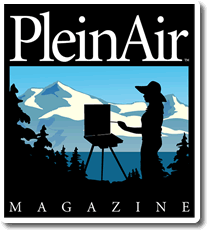
It’s not unusual for Maryland artist Hiu Lai Chong to spend a total of eight hours developing one of her plein air paintings, either in one long session that extends from dusk until dawn or over several days of painting under similar lighting conditions. Read about her approach to nocturnal paintings here and in the November 2012 issue of PleinAir magazine.
Hiu Lai Chong, who has been working as a full-time professional artist for only two years, began competing in quick draw competitions back in 2006, while she continued to hold a full-time job as a character artist at a video game development studio. In searching for unusual ways to present the landscape surrounding the location of a plein air festival, Chong began painting nocturnal scenes. Her painting “Night Light” won the Best of Show award in the 2012 Mountain Maryland competition in Cumberland, Maryland, and her painting “All Tucked In” took the Best of Show and People’s Choice awards in Plein Air Easton in 2012.
“I’ve always been interested in the idea of painting at night, when there is a sense of mystery about the landscape,” Chong explains. “The recent awards I’ve been fortunate to receive have certainly encouraged me to continue doing them. I love the idea of combining the artificial lights on buildings, the traffic lights, illuminated signs, and the light of the natural world. I first attempted to paint a night scene when I was taking a workshop in Philadelphia at Studio Incamminati in 2006, when I could see the lights on City Hall from my hotel window. When I got home, I investigated how other artists have painted nocturnes, and I picked up some ideas about how to create them more effectively.
“It helps to evaluate a potential painting location during the day and at night so I can determine what will become interesting and how the lights play against the structures. However, sometimes the most magical night scenes are totally uninteresting during the day, and that can make it hard to plan a nocturnal painting. In those situations, it is better just feel my way through the painting process without worrying about the accuracy of the drawing.”
Chong notes, “One of the advantages of working at night is that the scenes seldom change in appearance until the morning. I can paint without feeling the same pressure I do during the day, when the light is rapidly changing. I can spent all night on a painting, as I did with two of the pieces I created during Plein Air Easton. I started studying the building at the Chesapeake Bay Maritime Museum in St. Michaels, Maryland, before sunset, and by the time I started painting, it was dark. I had two overhead lights focused on my painting and palette, one of which was tied to a pole while the other was attached to a headband I was wearing. The headband gave me headaches after about two hours, so I had to take it off to get some relief, and then I put it back on and continued painting. I worked all night until the sunrise and then stopped. I was concerned about my safety, so my husband stayed with me for most of the night until he left to go to work in Washington.
“The other nocturne I did in Easton was a bigger and more complicated scene, but I was able to paint it from the safety of the Tidewater Hotel, looking across the street toward the Avalon Theatre. I spent four nights working on that one painting, and around 5 a.m., when I thought the rain was coming down, it turned out the sprinklers had come on in front of the hotel. During that fifth night of painting, I was under intense stress, trying to complete the painting in time to submit to the juried show. I hurried to finish before a storm moved in, and just as I was finishing the painting, it started pouring. I had to turn the painting upside down to keep it from getting wet as I ran into a sheltered area.”
Chong was not the only artist painting nocturnes during these recent plein air festivals, and she met up with a few others who were working through the night. “Tom Lynch gave me some valuable advice about bringing an extension cord and using a soft white light rather than a harsh flood lamp,” she says. “That did help me see the colors more accurately.” For more information, read the complete article in the November 2012 issue of PleinAir, or visit www.hiulaichong.com.




